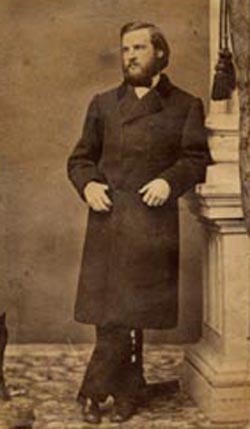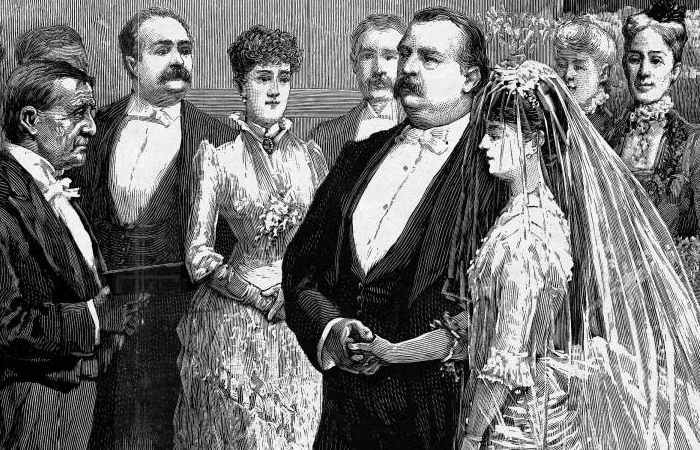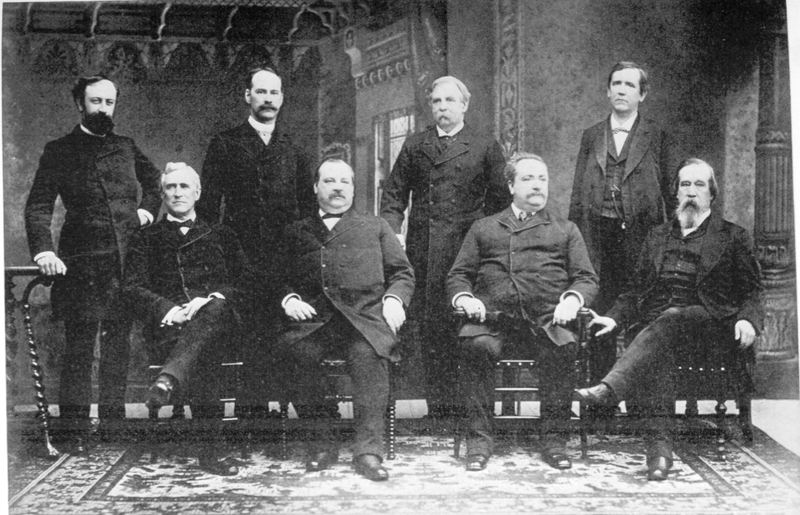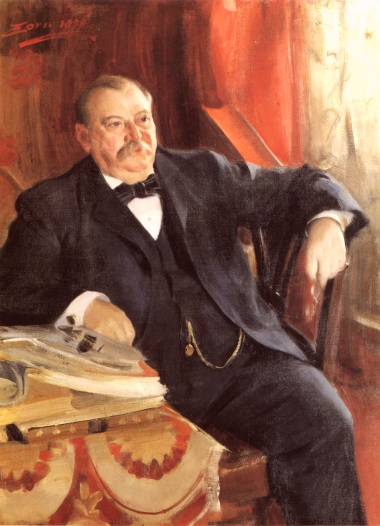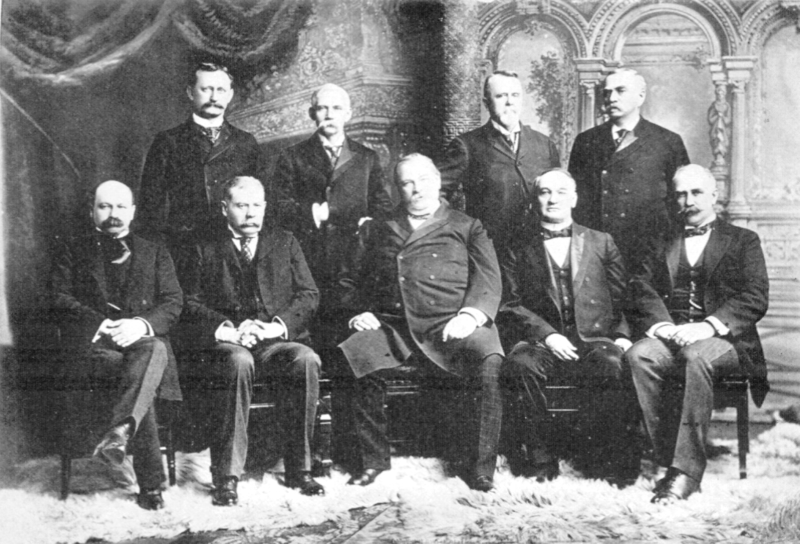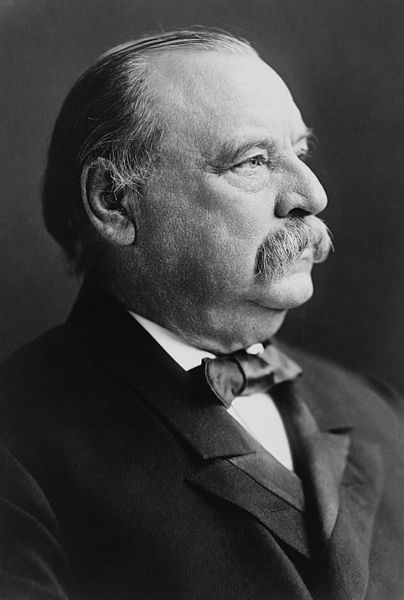<Back to Index>
- Historian Manuel de Faria e Sousa, 1590
- Painter Cornelis Ketel, 1548
- 22nd and 24th President of the United States Stephen Grover Cleveland, 1837
PAGE SPONSOR
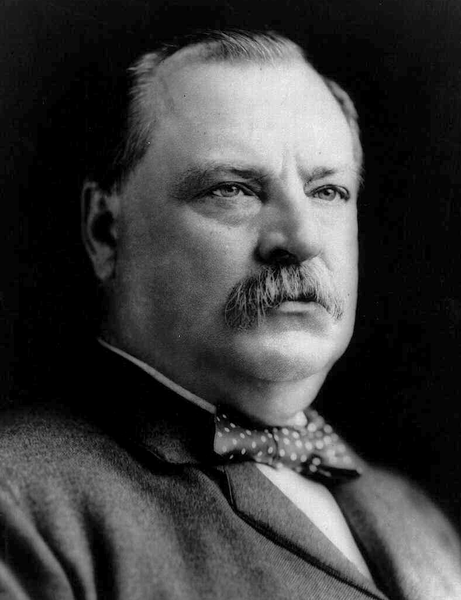
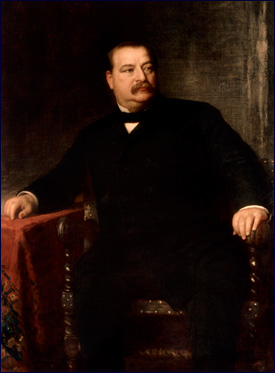
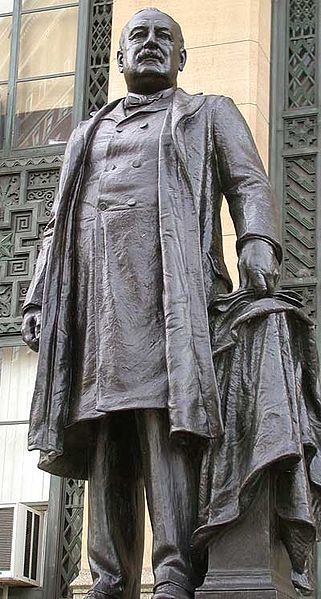
Stephen Grover Cleveland (March 18, 1837 June 24, 1908) was the 22nd and 24th President of the United States. Cleveland is the only president to serve two non-consecutive terms (1885 1889 and 1893 1897) and therefore is the only individual to be counted twice in the numbering of the presidents. He was the winner of the popular vote for president three times in 1884, 1888, and 1892 and was the only Democrat elected to the presidency in the era of Republican political domination that lasted from 1860 to 1912.
Cleveland was the leader of the pro-business Bourbon Democrats who opposed high tariffs, free silver, inflation, imperialism and subsidies to business, farmers or veterans. His battles for political reform and fiscal conservatism made him an icon for American conservatives. Cleveland won praise for his honesty, independence, integrity, and commitment to the principles of classical liberalism. As a reformer he worked indefatigably against political corruption, patronage, and bossism. His second term coincided with the Panic of 1893, a severe national depression that Cleveland was unable to reverse. It ruined his Democratic party, opening the way for Republican landslides in 1894 and 1896, and for the agrarian and silverite seizure of his Democratic party in 1896. The result was a political realignment that ended the Third Party System and launched the Fourth Party System and the Progressive Era.
Cleveland took strong positions and in turn took heavy criticism. His intervention in the Pullman Strike of 1894 to keep the railroads moving angered labor unions nationwide and angered the party in Illinois; his support of the gold standard and opposition to free silver alienated the agrarian wing of the Democratic Party. Furthermore, critics complained that he had little imagination and seemed overwhelmed by the nation's economic disasters depressions and strikes in his second term. Even so, his reputation for honesty and good character survived the troubles of his second term. Biographer Allan Nevins wrote, "in Grover Cleveland the greatness lies in typical rather than unusual qualities. He had no endowments that thousands of men do not have. He possessed honesty, courage, firmness, independence, and common sense. But he possessed them to a degree other men do not."
Stephen Grover Cleveland was born on March 18, 1837, in
Caldwell, New Jersey to Richard Falley Cleveland and Ann Neal Cleveland. Cleveland's father was a Presbyterian minister, originally from Connecticut. His mother was from Baltimore, the daughter of a bookseller. On his father's side, Cleveland was descended from English ancestors, the first Cleveland having emigrated to Massachusetts from northeastern England in 1635. On his mother's side, Cleveland was descended from Anglo - Irish Protestants and German Quakers from Philadelphia. He was distantly related to General Moses Cleaveland after whom the city of Cleveland, Ohio, was named.
Cleveland's elementary education came at the Fayetteville Academy and the Clinton Liberal Academy. After his father died in 1853, Cleveland left school and helped to support his family. Later that year, Cleveland's brother William was hired as a teacher at the New York Institute for the Blind in New York City, and William obtained a place for Cleveland as an assistant teacher. He returned home to Holland Patent at the end of 1854. An elder in his church offered to pay for his college education if he would promise to become a minister, but Cleveland declined. Instead, in 1855 Cleveland decided to move west. He stopped first in Buffalo, New York, where his uncle, Lewis W. Allen gave him a clerical job. Allen was an important man in Buffalo, and he introduced his nephew to influential men there, including the partners in the law firm of Rogers, Bowen, and Rogers. Cleveland later took a clerkship with the firm, and was admitted to the bar in 1859.
After becoming a lawyer, Cleveland worked for the Rogers firm for three years, leaving in 1862 to start his own practice. In January 1863, he was appointed assistant district attorney of Erie County. With the American Civil War raging, Congress passed the Conscription Act of 1863, requiring able - bodied men to serve in the army if called upon, or else to hire a substitute. Cleveland chose the latter course, paying George Benninsky, a thirty-two year old Polish immigrant, $150 to serve in his place. As a lawyer, Cleveland became known for his single minded concentration and dedication to hard work. In 1866, he defended some participants in the Fenian raid of that year, doing so successfully and free of charge. In 1868, Cleveland attracted some attention within his profession for his successful defense of a libel suit against the editor of the Commercial Advertiser, a Buffalo newspaper. During this time, Cleveland lived simply in a boarding house; although his income grew sufficient to support a more lavish lifestyle, Cleveland continued to support his mother and younger sisters. While his personal quarters were austere, Cleveland did enjoy an active social life and enjoyed "the easy going sociability of hotel lobbies and saloons."
From his earliest involvement in politics, Cleveland aligned himself with the Democratic Party. In 1865, he ran for District Attorney, losing narrowly to his friend and roommate, Lyman K. Bass, the Republican nominee. Cleveland then stayed out of politics until 1870 when, with the help of his friend, Oscar Folsom, he secured the Democratic nomination for sheriff of Erie County. At the age of thirty - three, Cleveland found himself elected sheriff by a 303 vote margin, taking office on January 1, 1871. While this new career took him away from the practice of law, it was rewarding in other ways: the fees were said to yield up to $40,000 (US$731 thousand in present terms) over the two year term. The most well known incident of his term involved the execution of a murderer, Patrick Morrisey, on September 6, 1872. Cleveland, as sheriff, was responsible for either personally carrying out the execution, or paying a deputy $10 to perform the task. Cleveland had qualms about the hanging, but opted to carry out the duty himself. He hanged another murderer, John Gaffney, on February 14, 1873.
After his term as sheriff ended, Cleveland returned to private practice, opening a law firm with his friends Lyman K. Bass and Wilson S. Bissell. Bass did not spend much time at the firm, being elected to Congress in 1873, but Cleveland and Bissell soon found themselves at the top of Buffalo's legal community. Up to that point, Cleveland's political career had been honorable but unremarkable. As biographer Allan Nevins wrote, "probably no man in the country, on March 4, 1881, had less thought than this limited, simple, sturdy attorney of Buffalo that four years later he would be standing in Washington and taking the oath as president of the United States."
In the 1870s, the government of Buffalo had grown increasingly corrupt, with Democratic and Republican political machines cooperating to share the spoils. When, in 1881, the Republicans nominated a slate of particularly disreputable machine politicians, the Democrats saw the opportunity to gain the votes of disaffected Republicans by nominating a more honest candidate. The party leaders approached Cleveland, and he agreed to run for mayor, provided that the rest of the ticket was to his liking. When the more notorious politicians were left off the Democratic ticket, Cleveland accepted the nomination. Cleveland was elected mayor with 15,120 votes, as against 11,528 for Milton C. Beebe, his opponent. He took office January 2, 1882.
Cleveland's term as mayor was spent fighting the entrenched interests of the party machines. Among the acts that established his reputation was a veto of the street cleaning bill passed by the Common Council. The street cleaning contract was open for bids, and the Council selected the highest bidder, rather than the lowest, because of the political connections of the bidder. While this sort of bipartisan graft had previously been tolerated in Buffalo, Mayor Cleveland would have none of it, and replied with a stinging veto message: "I regard it as the culmination of a most bare faced, impudent, and shameless scheme to betray the interests of the people, and to worse than squander the public money". The Council reversed themselves and awarded the contract to the lowest bidder. For this, and several other acts to safeguard the public funds, Cleveland's reputation as an honest politician began to spread beyond Erie County.
As Cleveland's reputation grew, state Democratic party officials began to consider him a possible nominee for governor. Daniel Manning, a party insider who admired Cleveland's record, promoted his candidacy. With a split in the state Republican party, 1882 looked to be a Democratic year, and there were several contenders for that party's nomination. The two leading Democratic candidates were Roswell P. Flower and Henry W. Slocum, but their factions deadlocked, and the convention could not agree on a nominee. Cleveland, in third place on the first ballot, picked up support in subsequent votes and emerged as the compromise choice. The Republican party remained divided against itself, and in the general election Cleveland emerged the victor, with 535,318 votes to Republican nominee Charles J. Folger's 342,464. Cleveland's margin of victory was, at the time, the largest in a contested New York election, and the Democrats also picked up seats in both houses of the legislature.
Continuing his opposition to unnecessary spending, Cleveland sent the legislature eight vetos in his first two months in office. The first to attract attention was his veto of a bill to reduce the fares on New York City elevated trains to five cents. The bill had broad support because the trains' owner, Jay Gould, was unpopular, and his fare increases were widely denounced. Cleveland saw the bill as unjust Gould had taken over the railroads when they were failing and had made the system solvent again. Moreover, Cleveland believed that altering Gould's franchise would violate the Contract Clause of the federal Constitution. Despite the initial popularity of the measure, the newspapers praised Cleveland's veto. Theodore Roosevelt, then a member of the Assembly, said that he had initially voted for the bill believing it was wrong, but wishing to punish the unscrupulous railroad barons. After the veto, Roosevelt reversed himself, as did many legislators, and the veto was sustained.
Cleveland's blunt, honest ways won him popular acclaim, but they also gained him the enmity of certain factions of his own party, especially the Tammany Hall organization in New York City. Tammany, under its boss, John Kelly, had not supported Cleveland's nomination as governor, and disliked him all the more when Cleveland openly opposed the re-election of one of their State Senators. Losing Tammany's support was balanced, however, by gaining the support of Theodore Roosevelt and other reform minded Republicans who helped Cleveland to pass several laws reforming municipal governments.
The Republicans convened in Chicago and nominated former Speaker of the House James G. Blaine of Maine for president on the fourth ballot. Blaine's nomination alienated many Republicans who viewed Blaine as ambitious and immoral. Democratic party leaders saw the Republicans' choice as an opportunity to take back the White House for the first time since 1856 if the right candidate could be found.
Among the Democrats, Samuel J. Tilden was the initial front runner, having been the party's nominee in the contested election of 1876. Tilden, however, was in poor health, and after he declined to be nominated, his supporters shifted to several other contenders. Cleveland was among the leaders in early support, but Thomas F. Bayard of Delaware, Allen G. Thurman of Ohio, Samuel Freeman Miller of Iowa, and Benjamin Butler of Massachusetts also had considerable followings, along with various favorite sons. Each of the other candidates had hindrances to his nomination: Bayard had spoken in favor of secession in 1861, making him unacceptable to Northerners; Butler, conversely, was reviled throughout the South for his actions during the Civil War; Thurman was generally well liked, but was growing old and infirm, and his views on the silver question were uncertain. Cleveland, too, had detractors Tammany remained opposed to him but the nature of his enemies made him still more friends. Cleveland led on the first ballot, with 392 votes out of 820. On the second ballot, Tammany threw its support behind Butler, but the rest of the delegates shifted to Cleveland, and he was nominated. Thomas A. Hendricks of Indiana was selected as his running mate.
After Cleveland's nomination, reform minded Republicans called " Mugwumps" denounced Blaine as corrupt and flocked to Cleveland. The Mugwumps, including such men as Carl Schurz and Henry Ward Beecher, were more concerned with ideals than with party, and hoped that Cleveland would endorse their crusade for civil service reform and efficiency in government. At the same time the Democrats gained support from the Mugwumps, they lost some to the Greenback - Labor party, led by ex-Democrat Benjamin Butler.
Each candidate's supporters cast aspersions on their opponents. Cleveland's supporters rehashed the old allegations that Blaine had corruptly influenced legislation in favor of the Little Rock & Fort Smith Railroad and the Northern Pacific Railway, later profiting on the sale of bonds he owned in both companies. Although the stories of Blaine's favors to the railroads had made the rounds eight years earlier, this time Blaine's correspondence was discovered, making his earlier denials less plausible. On some of the most damaging correspondence, Blaine had written "Burn this letter," giving Democrats the last line to their rallying cry: "Blaine, Blaine, James G. Blaine, the continental liar from the state of Maine, 'Burn this letter!"
To counter Cleveland's image of purity, his opponents reported that Cleveland had fathered an illegitimate child while he was a lawyer in Buffalo. The derisive phrase "Ma, Ma, where's my Pa?" rose as an unofficial campaign slogan for those who opposed him. When confronted with the emerging scandal, Cleveland's instructions to his campaign staff were: "Tell the truth." Cleveland admitted to paying child support in 1874 to Maria Crofts Halpin, the woman who claimed he fathered her child named Oscar Folsom Cleveland. Halpin was involved with several men at the time, including Cleveland's friend and law partner, Oscar Folsom, for whom the child was also named. Cleveland did not know which man was the father, and is believed to have assumed responsibility because he was the only bachelor among them.
Both candidates believed that the states of New York, New Jersey, Indiana, and Connecticut would determine the election. In New York, the Tammany Hall, after vacillating, decided that they would gain more from supporting a Democrat they disliked than a Republican who would do nothing for them. Blaine hoped that he would have more support from Irish Americans than Republicans typically did; while the Irish were mainly a Democratic constituency in the 19th century, Blaine's mother was Irish Catholic, and he had been supportive of the Irish National Land League while he was Secretary of State. The Irish, a significant group in three of the swing states, did appear inclined to support Blaine until one of his supporters, Samuel D. Burchard, gave a speech denouncing the Democrats as the party of "Rum, Romanism, and Rebellion". The Democrats spread the word of this insult in the days before the election, and Cleveland narrowly won all four of the swing states, including New York by just over one thousand votes. While the popular vote total was close, with Cleveland winning by just one-quarter of a percent, the electoral votes gave Cleveland a majority of 219 182. Following the electoral victory, the "Ma, Ma ..." attack phrase gained a classic rejoinder: "Gone to the White House. Ha! Ha! Ha!"
Soon after taking office, Cleveland was faced with the task of filling all the government jobs for which the president had the power of appointment. These jobs were typically filled under the spoils system, but Cleveland announced that he would not fire any Republican who was doing his job well, and would not appoint anyone solely on the basis of party service. He also used his appointment powers to reduce the number of federal employees, as many departments had become bloated with political time servers. Later in his term, as his fellow Democrats chafed at being excluded from the spoils, Cleveland began to replace more of the partisan Republican office holders with Democrats. While some of his decisions were influenced by party concerns, more of Cleveland's appointments were decided by merit alone than was the case in his predecessors' administrations.
Cleveland also reformed other parts of the government. In 1887 he signed an act creating the Interstate Commerce Commission. He and Secretary of the Navy William C. Whitney undertook to modernize the navy and canceled construction contracts that had resulted in inferior ships. Cleveland angered railroad investors by ordering an investigation of western lands they held by government grant. Secretary of the Interior Lucius Q.C. Lamar charged that the rights of way for this land must be returned to the public because the railroads failed to extend their lines according to agreements. The lands were forfeited, resulting in the return of approximately 81,000,000 acres (330,000 km2).
Cleveland faced a Republican Senate and often resorted to using his veto powers. He vetoed hundreds of private pension bills for American Civil War veterans, believing that if their pensions requests had already been rejected by the Pensions Bureau, Congress should not attempt to override that decision. When Congress, pressured by the Grand Army of the Republic, passed a bill granting pensions for disabilities not caused by military service, Cleveland also vetoed that. Cleveland used the veto far more often than any president up to that time. In 1887, Cleveland issued his most well known veto, that of the Texas Seed Bill. After
a drought had ruined crops in several Texas counties, Congress
appropriated $10,000 to purchase seed grain for farmers there. Cleveland vetoed the expenditure. In his veto message, he espoused a theory of limited government.
One of the most volatile issues of the 1880s was whether the currency should be backed by gold and silver, or by gold alone. The issue cut across party lines, with western Republicans and southern Democrats joining together in the call for the free coinage of silver, and both parties' representatives in the northeast holding firm for the gold standard. Because silver was worth less than its legal equivalent in gold, taxpayers paid their government bills in silver, while international creditors demanded payment in gold, resulting in a depletion of the nation's gold supply.
Cleveland and Treasury Secretary Daniel Manning stood firmly on the side of the gold standard, and tried to reduce the amount of silver that the government was required to coin under the Bland - Allison Act of 1878. This angered Westerners and Southerners, who advocated for cheap money to help their poorer constituents. In reply, one of the foremost silverites, Richard P. Bland, introduced a bill in 1886 that would require the government to coin unlimited amounts of silver, inflating the then deflating currency. While Bland's bill was defeated, so was a bill the administration favored that would repeal any silver coinage requirement. The result was a retention of the status quo, and a postponement of the resolution of the free silver issue.
Another contentious financial issue at the time was the protective tariff. While it had not been a central point in his campaign, Cleveland's opinion on the tariff was that of most Democrats: that the tariff ought to be reduced. Republicans generally favored a high tariff to protect American industries. American tariffs had been high since the Civil War, and by the 1880s the tariff brought in so much revenue that the government was running a surplus.
In 1886, a bill to reduce the tariff was narrowly defeated in the House. The tariff issue was emphasized in the Congressional elections that year, and the forces of protectionism increased their numbers in the Congress. Nevertheless, Cleveland continued to advocate tariff reform. As the surplus grew, Cleveland and the reformers called for a tariff for revenue only. His message to Congress in 1887 pointed out the injustice of taking more money from the people than the government needed to pay for its operating expenses. Republicans, as well as protectionist northern Democrats like Samuel J. Randall, believed that without high tariffs American industries would fail, and continued to fight reformers' efforts. Roger Q. Mills, the chairman of the House Committee on Ways and Means, proposed a bill that would reduce the tariff burden from about 47% to about 40%. After significant exertions by Cleveland and his allies, the bill passed the House. The Republican Senate, however, failed to come to agreement with the Democratic House, and the bill died in the conference committee. Dispute over the tariff would carry over into the 1888 presidential election.
Cleveland was a committed non-interventionist who had campaigned in opposition to expansion and imperialism. He refused to promote the previous administration's Nicaragua canal treaty, and generally was less of an expansionist in foreign relations. Cleveland's Secretary of State, Thomas F. Bayard, negotiated with Joseph Chamberlain of the United Kingdom over fishing rights in the waters off Canada, and struck a conciliatory note, despite the opposition of New England's Republican Senators. Cleveland also withdrew from Senate consideration the Berlin Conference treaty which guaranteed an open door for U.S. interests in the Congo.
Cleveland, like a growing number of Northerners (and nearly all white Southerners) saw Reconstruction as a failed experiment, and was reluctant to use federal power to enforce the 15th Amendment of the U.S. Constitution, which guaranteed voting rights to African Americans. Cleveland initially appointed no black Americans to patronage jobs, but did allow Frederick Douglass to continue in his post as recorder of deeds in Washington, D.C. When Douglass later resigned, Cleveland appointed another black man to replace him.
Although Cleveland had condemned the "outrages" against Chinese immigrants, he believed that Chinese immigrants were unwilling to assimilate into white society. Secretary of State Bayard negotiated an extension to the Chinese Exclusion Act, and Cleveland lobbied the Congress to pass the Scott Act, written by Congressman William Lawrence Scott, which would prevent Chinese immigrants who left the United States from returning. The Scott Act easily passed both houses of Congress, and Cleveland signed it into law on October 1, 1888.
Cleveland viewed Native Americans as wards of the state, saying in his first inaugural address that "[t]his guardianship involves, on our part, efforts for the improvement of their condition and enforcement of their rights." He encouraged the idea of cultural assimilation, pushing for the passage of the Dawes Act, which provided for distribution of Indian lands to individual members of tribes, rather than having them continued to be held in trust for the tribes by the federal government. While a conference of Native leaders endorsed the act, in practice the majority of Native Americans disapproved of it. Cleveland believed the Dawes Act would lift Native Americans out of poverty and encourage their assimilation into white society, but its ultimate effect was to weaken the tribal governments and allow individual Indians to sell land and keep the money.
Cleveland
entered the White house as a bachelor, but did not remain one for long.
In 1885, the daughter of Cleveland's friend Oscar Folsom visited him in
Washington. Frances Folsom was a student at Wells College, and when she returned to school Cleveland received her mother's permission to correspond with her. They were soon engaged to be married. On June 2, 1886, Cleveland married Frances in the Blue Room in the White House. He was the second president to marry while in office, and the only president to have a wedding in the White House. This
marriage was unusual because Cleveland was the executor of Oscar
Folsom's estate and had supervised Frances' upbringing, but the public
did not, in general, take exception to the match. At twenty-one years old, Frances was the youngest ever First Lady, but the public soon warmed to her beauty and warm personality. The Clevelands had five children: Ruth (1891 1904); Esther (1893 1980); Marion (1895 1977); Richard Folsom (1897 1974); and Francis Grover (1903 1995). The British philosopher Philippa Foot was their granddaughter.
During his first term, Cleveland successfully appointed two justices to the Supreme Court of the United States. The first, Lucius Q.C. Lamar, was a former Mississippi Senator then serving in Cleveland's Cabinet as Interior Secretary. When William Burnham Woods died, Cleveland nominated Lamar to his seat in late 1887. While Lamar had been well liked as a Senator, his service under the Confederacy two decades earlier caused many Republicans to vote against him. Lamar's nomination was confirmed by the narrow margin of 32 to 28.
Chief Justice Morrison Waite died a few months later, and Cleveland nominated Melville Fuller to his seat on April 30, 1888. Cleveland had previously offered to nominate Fuller to the Civil Service Commission, but Fuller had declined to leave his Chicago law practice. Fuller accepted the Supreme Court nomination, and the Senate Judiciary Committee spent several months examining the little known nominee. The Senate confirmed the nomination 41 to 20.
Cleveland
appointed a total of 45 federal judges. In addition to his four Supreme
Court appointments, these included two judges to the
United States circuit courts, nine judges to the United States Courts of Appeals, and 30 judges to the United States district courts.
Because Cleveland served terms both before and after Congress
eliminated the circuit courts in favor of the Courts of Appeals, he is
one of only two Presidents to have appointed judges to both bodies. The
other, Benjamin Harrison, was in office at the time that the change was
made. Thus, all of Cleveland's appointments to the circuit courts were
made in his first term, and all of his appointments to the Courts of
Appeals were made in his second.
The debate over tariff reduction continued into the 1888 presidential campaign. The Republicans nominated Benjamin Harrison of Indiana for president and Levi P. Morton of New York for vice president. Cleveland was easily renominated at the Democratic convention in St. Louis. Vice President Hendricks died in 1885, so the Democrats chose Allen G. Thurman of Ohio to be Cleveland's running mate. The Republicans campaigned heavily on the tariff issue, turning out protectionist voters in the important industrial states of the North. Further, the Democrats in New York were divided over the gubernatorial candidacy of David B. Hill, weakening Cleveland's support in that swing state.
As in 1884, the election focused on the swing states of New York, New Jersey, Connecticut, and Indiana. Unlike that year, when Cleveland triumphed in all four, in 1888 he won only two, losing his home state of New York by 14,373 votes. More notoriously, the Republicans were victorious in Indiana, largely as the result of fraud. Republican victory in that state, where Cleveland lost by just 2,348 votes, was sufficient to propel Harrison to victory, despite his loss of the nationwide popular vote. Cleveland continued his duties diligently until the end of the term and began to look forward to return to private life.
As Frances Cleveland left the White House, she told a staff member, "Now, Jerry, I want you to take good care of all the furniture and ornaments in the house, for I want to find everything just as it is now, when we come back again." When asked when she would return, she responded, "We are coming back four years from today." In the meantime, the Clevelands moved to New York City where Cleveland took a position with the law firm of Bangs, Stetson, Tracy, and MacVeigh, a predecessor to the present day firm Davis Polk & Wardwell. Cleveland's income with the firm was not high, but neither were his duties especially onerous. While they lived in New York, the Clevelands' first child, Ruth, was born in 1891.
The Harrison administration worked with Congress to pass the McKinley Tariff and the Sherman Silver Purchase Act, two policies Cleveland deplored as dangerous to the nation's financial health. At first he refrained from criticizing his successor, but by 1891 Cleveland felt compelled to speak out, addressing his concerns in an open letter to a meeting of reformers in New York. The "silver letter" thrust Cleveland's name back into the spotlight just as the 1892 election was approaching.
Cleveland's
stature as an ex-president and recent pronouncements on the monetary
issues made him a leading contender for the Democratic nomination. His leading opponent was David B. Hill, who was by that time a Senator for New York. Hill
united the anti Cleveland elements of the Democratic party silverites,
protectionists, and Tammany Hall but was unable to create a coalition
large enough to deny Cleveland the nomination. Despite some desperate maneuvering by Hill, Cleveland was nominated on the first ballot at the convention in Chicago. For vice president, the Democrats chose to balance the ticket with Adlai E. Stevenson of Illinois, a silverite. Although the Cleveland forces preferred Isaac P. Gray of Indiana for vice president, they accepted the convention favorite. As a supporter of using greenbacks and free silver to
inflate the currency and alleviate economic distress in the rural
districts, Stevenson balanced the ticket headed by Cleveland, the hard money, gold standard supporter.
Shortly after Cleveland's second term began, the Panic of 1893 struck the stock market, and he soon faced an acute economic depression. The panic was worsened by the acute shortage of gold that resulted from the free coinage of silver, and Cleveland called Congress into session early to deal with the problem. The debate over the coinage was as heated as ever, but the effects of the panic had driven more moderates to support repealing the free coinage provisions of the Sherman Silver Purchase Act. Even so, the silverites rallied their following at a convention in Chicago, and the House of Representatives debated for fifteen weeks before passing the repeal by a considerable margin. In the Senate, the repeal of free coinage was equally contentious, but Cleveland convinced enough Democrats to stand by him that they, along with eastern Republicans, formed a 48 37 majority. With the passage of the repeal, the Treasury's gold reserves were restored to safe levels. At the time the repeal seemed a minor setback to silverites, but it marked the beginning of the end of silver as a basis for American currency.
Having succeeded in reversing the Harrison administration's silver policy, Cleveland sought next to reverse the effects of the McKinley tariff. What would become the Wilson - Gorman Tariff Act was introduced by West Virginian Representative William L. Wilson in December 1893. After lengthy debate, the bill passed the House by a considerable margin. The bill proposed moderate downward revisions in the tariff, especially on raw materials. The shortfall in revenue was to be made up by an income tax of two percent on income above $4,000 (US$97.5 thousand in present terms).
The bill was next considered in the Senate, where opposition was stronger. Many Senators, led by Arthur Pue Gorman of Maryland, wanted more protection for their states' industries than the Wilson bill allowed. Others, such as Morgan and Hill, opposed partly out of a personal enmity toward Cleveland. By the time the bill left the Senate, it had more than 600 amendments attached that nullified most of the reforms. The Sugar Trust in particular lobbied for changes that favored it at the expense of the consumer. Cleveland was unhappy with the result, and denounced the revised measure as a disgraceful product of the control of the Senate by trusts and business interests. Even so, he believed it was an improvement over the McKinley tariff and allowed it to become law without his signature.
The Panic of 1893 had damaged labor conditions across the United States, and the victory of anti-silver legislation worsened the mood of western laborers. A group of working men led by Jacob S. Coxey began to march east toward Washington, D.C. to protest Cleveland's policies. This group, known as Coxey's Army, agitated in favor of a national roads program to give jobs to workingmen, and a weakened currency to help farmers pay their debts. By the time they reached Washington, only a few hundred remained, and when they were arrested the next day for walking on the grass of the United States Capitol, the group scattered. Coxey's Army was never a threat to the government, but it showed a growing dissatisfaction in the West with Eastern monetary policies.
The Pullman Strike had a significantly greater impact than Coxey's Army. A strike began against the Pullman Company over low wages and twelve hour workdays, and sympathy strikes, led by American Railway Union leader Eugene V. Debs, soon followed. By June 1894, 125,000 railroad workers were on strike, paralyzing the nation's commerce. Because the railroads carried the mail, and because several of the affected lines were in federal receivership, Cleveland believed a federal solution was appropriate. Cleveland obtained an injunction in federal court, and when the strikers refused to obey it, he sent in federal troops to Chicago and 20 other rail centers. "If it takes the entire army and navy of the United States to deliver a postcard in Chicago," he proclaimed, "that card will be delivered." Most governors supported Cleveland except Democrat John P. Altgeld of Illinois, who became his bitter foe in 1896. Leading newspapers of both parties applauded Cleveland's actions, but the use of troops hardened the attitude of organized labor toward his administration.
When Cleveland took office he faced the question of Hawaiian annexation. In his first term, Cleveland had supported free trade with Hawai'i and accepted an amendment that gave the United States a coaling and naval station in Pearl Harbor. In the intervening four years, Honolulu businessmen of European and American ancestry had denounced Queen Liliuokalani as a tyrant who rejected constitutional government; in early 1893 they overthrew her, set up a republican government under Sanford B. Dole, and sought to join the United States. The Harrison administration had quickly agreed with representatives of the new government on a treaty of annexation and submitted it to the Senate for approval. Five days after taking office on March 9, 1893, Cleveland withdrew the treaty from the Senate and sent former Congressman James Henderson Blount to Hawai'i to investigate the conditions there.
Cleveland agreed with Blount's report, which found the populace to be opposed to annexation. Liliuokalani refused to grant amnesty as a condition of her reinstatement, saying that she would execute the current government in Honolulu, and Dole's government refused to yield their position. By December 1893, the matter was still unresolved, and Cleveland referred the issue to Congress. In his message to Congress, Cleveland rejected the idea of annexation and encouraged the Congress to continue the American tradition of non intervention. The Senate, under Democratic control but hostile to Cleveland, produced the Morgan Report, which contradicted Blount's findings and found the overthrow was a completely internal affair. Cleveland dropped all talk of reinstating the Queen, and went on to recognize and maintain diplomatic relations with the new Republic of Hawaii.
Closer to home, Cleveland adopted a broad interpretation of the Monroe Doctrine that did not just simply forbid new European colonies but declared an American interest in any matter within the hemisphere. When Britain and Venezuela disagreed over the boundary between the latter nation and the colony of British Guiana, Cleveland and Secretary of State Richard Olney protested. British prime minister Lord Salisbury and the British ambassador to Washington, Julian Pauncefote misjudged the importance the American government placed on the dispute, prolonging the crisis before ultimately accepting the American demand for arbitration. A tribunal convened in Paris in 1898 to decide the matter, and in 1899 awarded the bulk of the disputed territory to British Guiana. By standing with a Latin American nation against the encroachment of a colonial power, Cleveland improved relations with the United States' southern neighbors, but the cordial manner in which the negotiations were conducted also made for good relations with Britain.
In the midst of the fight for repeal of free silver coinage in 1893, Cleveland sought the advice of the White House doctor, Dr. O'Reilly, about soreness on the roof of his mouth and a crater like edge ulcer with a granulated surface on the left side of Cleveland's hard palate. Samples of the tumor were sent anonymously to the army medical museum. The diagnosis was not a malignant cancer, but instead an epithelioma. Several doctors, including Dr. William W. Keen, Professor of Surgery at Jefferson Medical College in Philadelphia, stated after Cleveland's death that the tumor was a carcinoma. As a result of Cleveland enjoying many more years of life after the tumor removal, there was some debate as to whether or not it was truly a malignancy. Other suggestions included a meloblastoma or a benign salivary mixed tumor (also known as a pleomorphic adenoma). In the 1980s, analysis of the specimen finally confirmed the tumor to be verrucous carcinoma, a low - grade epithelial cancer with a low potential for metastasis.
Because of the financial depression of the country, Cleveland decided to have surgery performed in secrecy to avoid further market panic. The surgery occurred on July 1, to give Cleveland time to make a full recovery in time for the upcoming Congressional session. Under the guise of a vacation cruise, Cleveland and his surgeon, Dr. Joseph Bryant, left for New York. The surgeons operated aboard the yacht Oneida as it sailed off Long Island. The surgery was conducted through the president's mouth, to avoid any scars or other signs of surgery. The team, sedating Cleveland with nitrous oxide and ether, successfully removed parts of his upper left jaw and hard palate. The size of the tumor and the extent of the operation left Cleveland's mouth disfigured. During another surgery, an orthodontist fitted Cleveland with a hard rubber prosthesis that corrected his speech and restored his appearance.
A cover story about the removal of two bad teeth kept the suspicious press placated. Even when a newspaper story appeared giving details of the actual operation, the participating surgeons discounted the severity of what transpired during Cleveland's vacation. In 1917, one of the surgeons present on the Oneida, Dr. William W. Keen, wrote an article detailing the operation.
Cleveland's trouble with the Senate hindered the success of his nominations to the Supreme Court in his second term. In 1893, after the death of Samuel Blatchford, Cleveland nominated William B. Hornblower to the Court. Hornblower, the head of a New York City law firm, was thought to be a qualified appointee, but his campaign against a New York machine politician had made Senator David B. Hill his enemy. Further, Cleveland had not consulted the Senators before naming his appointee, leaving many who were already opposed to Cleveland on other grounds even more aggrieved. The Senate rejected Hornblower's nomination on January 15, 1894, by a vote of 30 to 24.
Cleveland continued to defy the Senate by next appointing Wheeler Hazard Peckham another New York attorney who had opposed Hill's machine in that state. Hill used all of his influence to block Peckham's confirmation, and on February 16, 1894, the Senate rejected the nomination by a vote of 32 to 41. Reformers urged Cleveland to continue the fight against Hill and to nominate Frederic R. Coudert, but Cleveland acquiesced in an inoffensive choice, that of Senator Edward Douglass White of Louisiana, whose nomination was accepted unanimously. Later, in 1896, another vacancy on the Court led Cleveland to consider Hornblower again, but he declined to be nominated. Instead, Cleveland nominated Rufus Wheeler Peckham, the brother of Wheeler Hazard Peckham, and the Senate confirmed the second Peckham easily.
In Cleveland's first term, no new states had been admitted in more than a decade, owing to Congressional Democrats' reluctance to admit states that they believed would send Republican members. When Harrison took office, he and the Republican Congress admitted six states -- North Dakota, South Dakota, Montana, Washington, Idaho, and Wyoming -- all of which were expected to send Republican delegations. Utah, however, was believed to be Democratic. This, combined with uncertainty about Mormon polygamy (disavowed in 1890), led it to be excluded from the new states. When Cleveland won election to a second term, he and the Democratic majority in the 53rd United States Congress passed an Enabling Act in 1894 that permitted Utah to apply for statehood. Utah joined the Union on January 4, 1896.
Cleveland's agrarian and silverite enemies gained control of the Democratic party in 1896, repudiated his administration and the gold standard, and nominated William Jennings Bryan on a Silver Platform. Cleveland silently supported the Gold Democrats' third party ticket that promised to defend the gold standard, limit government, and oppose high tariffs, but declined to accept their nomination for a third term. The party won only 100,000 votes in the general election, and William McKinley, the Republican nominee, triumphed easily over Bryan. Agrarians would later nominate Bryan again in 1900, but in 1904 the conservatives, with Cleveland's support, regained control of the Democratic Party and nominated Alton B. Parker.
After leaving the White House on March 4, 1897, Cleveland lived in retirement at his estate, Westland Mansion, in Princeton, New Jersey. For a time he was a trustee of Princeton University, and was one of the majority of trustees who preferred Dean West's plans for the Graduate School and undergraduate living over those of Woodrow Wilson, then president of the university. Cleveland consulted occasionally with President Theodore Roosevelt (1901 1909), but was financially unable to accept the chairmanship of the commission handling the Coal Strike of 1902. Cleveland still made his views known in political matters. In a 1905 article in The Ladies Home Journal, Cleveland weighed in on the women's suffrage movement, writing that "sensible and responsible women do not want to vote. The relative positions to be assumed by men and women in the working out of our civilization were assigned long ago by a higher intelligence."
Cleveland's health had been declining for several years, and in the autumn of 1907 he fell seriously ill. In 1908, he suffered a heart attack and died. His last words were "I have tried so hard to do right." He is buried in the Princeton Cemetery of the Nassau Presbyterian Church.
In his first term in office, Cleveland sought a summer house to escape the heat and smells of Washington, D.C., but needed to remain near the capital. Acting in secret, he located a house, Oak View (or Oak Hill), in a rural upland part of the District of Columbia, and bought it in 1886. Although he sold Oak View upon leaving the White House (the first time), the area became known as Cleveland Park, which name it still bears. The Clevelands are depicted in local murals.
Grover Cleveland Hall at Buffalo State College in Buffalo, New York. Cleveland Hall houses the offices of the college president, vice presidents, and other administrative functions and student services. Cleveland was a member of the first board of directors of the then Buffalo Normal School. Grover Cleveland Middle School in his birthplace, Caldwell, New Jersey, was named for him, as is Grover Cleveland High School in Buffalo, New York, and the town of Cleveland, Mississippi. Mount Cleveland, a volcano in Alaska, is also named after him.
Cleveland's portrait was on the U.S. $1000 bill of series 1928 and series 1934. He also appeared on the first few issues of the $20 Federal Reserve Notes from 1914. Since he was both the 22nd and 24th president, he will be featured on two separate dollar coins to be released in 2012 as part of the Presidential $1 Coin Act of 2005.
In
2006, Free New York, a nonprofit and nonpartisan research group, began
raising funds to purchase the former Fairfield Library in Buffalo, New York and transform it into the Grover Cleveland Presidential Library & Museum.
